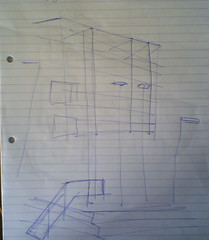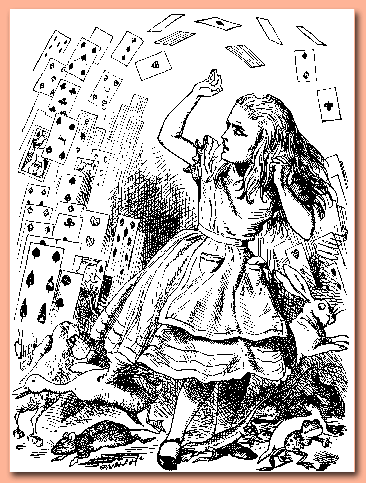Rosi Braidotti
Nomadic SubjectsLuce Irigaray
This Sex Which is Not OneRosi Braidotti
Cyberfeminism with a DifferenceIrigaray
Paul: Irigaray seemed almost entirely about "dicks" and "vaginas."
Jess: it's about "bodies."
Andy: First chapter of Irigaray (on Alice) "skirts" the issue.
"Irigaray questions the assumption that female sexuality is dependent upon male sexuality. She asks and attempts to answer, such questions as, Where is female sexuality located if it always refers back to the penis? Where does female pleasure reside? What is female desire and what does it look like, if it looks like anything at all? And why does Freud insist that the penis is the only true sex organ?"
Homosexuality for Irigaray is not sexual but economic.
"Irigaray says that in this phallogocentric model, the kind of sexuality that gets privileged is one based on looking because the one sexual organ, the penis, is visible. So the Freudian model of sexuality, which privileges the penis, is based on the visual; it is scopophilic.
They (girls) notice the penis of a brother or playmate, strikingly visible and of large proportions, at once recognize it as the superior counterpart of their own small and inconspicuous organ, and from that time forward fall a victim to envy for the penis. (Sexuality and the Psychology of Love, "Anatomical Distinction Between the Sexes", pg.177.)
Male sexuality is based on having a penis, which is privileged because it can be seen; it is visible (and larger); therefore, it is superior. In contrast, a woman's sexual organ(s) cannot be seen; therefore it is inferior and becomes equated with having nothing. In other words, male sexuality is based on having a penis, female sexuality is based on having nothing. This system sets up the simple binary opposition of penis/nothing.
According to Freud, since women have nothing, women are always trying to get a penis for themselves in order to fill the lack: " A little girl . . . makes her judgment and her decision in a flash. She has seen it and knows that she is without it and wants to have it" (Ibid, pg. 177). Freud theorizes that women do one or a combination of the following three things in order to fulfill the desire to have a penis:
1. She will try to acquire the penis for herself by having a baby, especially a male baby.
But now the girl's libido slips into a new position by means - there is no other way of putting it - of the equation "penis=child." She gives up her wish for a penis and puts in place of it a wish for a child (Ibid, p. 180-81).
This desire has its roots in the Oedipus Complex, when the female child yearns to have a baby by her father to make up for her lack of a penis. This "wish" is repressed and redirected to having a baby with a man other than her father.
2. She will find or attempt to find a husband who is like her father, whom she believes is capable of giving it (the penis) to her. In fact, Freud believes that in certain cases newly married women "wish to castrate the young husband and keep his penis" (Ibid, p.72).
3. She will try to procure the masculine rights and privileges that the penis represents:
The hope of someday obtaining a penis in spite of everything and so of becoming like a man may persist to an incredibly late age and may become a motive for the strangest and otherwise unaccountable actions. Or again, a process may set in which might be described as a "denial," ....Thus a girl may refuse to accept the fact of being castrated, may harden herself in the conviction that she does possess a penis and may subsequently be compelled to behave as though she were a man. (Ibid, pg. 178)
According to Freud, if a woman acts like a man, i.e., rational, logic, etc, she is in essence denying the `fact of her castration' and is neurotic.
Therefore, according to Irigaray's reading of Freud, in the Freudian paradigm, female desire is always the desire for a penis to fill the lack or nothingness. Male desire, on the other hand, is to get back to the mother's body, to have sexual relations with his mother as is evidenced in the Oedipus complex. The result is that male and female desire look different; the female attempts to fill her desire by getting a penis, and the male attempts to fill his desire by having sex with a female other than his mother.
Braidotti
Nomadic Subjectivity:
Andy: it is not a migrant but a nomadic as the fact you are constantly going.
how about in a feminist framework:
Andy: you are doing something rather than trying to become an outward goal that we get there, it is an evolving thing.
"The practice of "as-if", for Braidotti, is a "technique of strategic re-location in order to rescue what we need of the past in order to trace paths of transformation of our lives here and now."(p.6) Braidotti also understands "as-if" as "the affirmation of fluid boundaries, a practice of the intervals, of the interfaces, and the interstices." While grounded in postmodernist theory of repetition, parody, pastiche, etc., Braidotti is insistent that for "as-if" to be useful, it must be grounded in deliberate agency and lived experience. Postmodern subversions and parody "can be politically empowering on the condition of being sustained by a critical consciousness that aims at engendering transformations and changes." (p.7)
What makes a pastiche useful?
Andy: changes contexts. And, that context is lived experience.
Paul: but we shouldn't just do something different but something better...
But, there are no value-judgements in pomo...
What's wrong with "identity?:
Paul - it's static
Andy - identity is defined by whats round you while nomadism is defined by what you are
""desire to leave behind the linear mode of intellectual thinking, the teleologically ordained style of argumentation that most of us have been trained to respect and emulate" (29)
Braidotti - Cyberfeminism
Paul: Braidotti is saying that the visual is purely a masculine preserve and the female way to interact with things is a more sensory/audio/feel/touch language rather than looking at things. Because looking at things objectifies things.
Andy: Science fiction is good as it allows for alternative perspectives
Paul: see ikon gallery's set up on the future using *trashy* sci-fi (planets of the apes future). For Braidotti it's a way of imagining other ways of looking at things
Andy: alternative views openes it up to alternative organisations and societies etc...
Andy: in sci-fi you get entirely female societies
Jess: Is a single gender society better then?
Paul: are there roles in society better performed by women?
Jess: argghhhhhhhhhh!!!!!
Paul: but there are lots of ways of being "male"
Andy: it comes down to being a person, not a gender.
Jess: what about "being"....how about "becoming."
"The central point remains: there is a credibility gap between the promises of Virtual Reality and cyberspace and the quality of what it delivers. It consequently seems to me that, in the short range, this new technological frontier will intensify the gender-gap and increase the polarisation between the sexes. We are back to the war metaphor, but its location is the real world, not the hyperspace of abstract masculinity. And its protagonists are no computer images, but the real social agents of postin dustrial urban landscapes.
The most effective strategy remains for women to use technology in order to disengage our collective imagination from the phallus and its accessory values: money, exclusion and domination, nationalism, iconic femininity and systematic violence."
Web 2.0 and Feminism
The web is platform.
Paul: people can change their identities etc... online, nothing is static.
Paul: there isn't a sense that the "now" has any sense of permanence.
Paul: is there an ideological stance in feminism today? Or is it universal?
Andy: a difference acknowledged today between everyone is the same and everyone is different.
Jess: Context is crucial.
Feminist Manifesto:
Paul: defining it as feminism is limiting
Jess: by why is it important today that we think about gender?
Andy: (from blog post) "A "male" writer could be interpreted as "female" and vice versa. Writing without signifiers becomes androgynous. If all writing is androgynous and all users are reduced to text, then all users are androgynous. With a lack of signifiers, things other than gender can also be disregarded (age, race, etc)."
Andy: but gender isn't one or the other, so why don't we disregard it?
Andy: we exist on a gender spectrum.
Paul: "there is no gender spectrum."
Jess: but that implies there is a beginning and an end
Jess: read Judith Butler Gender Butler











